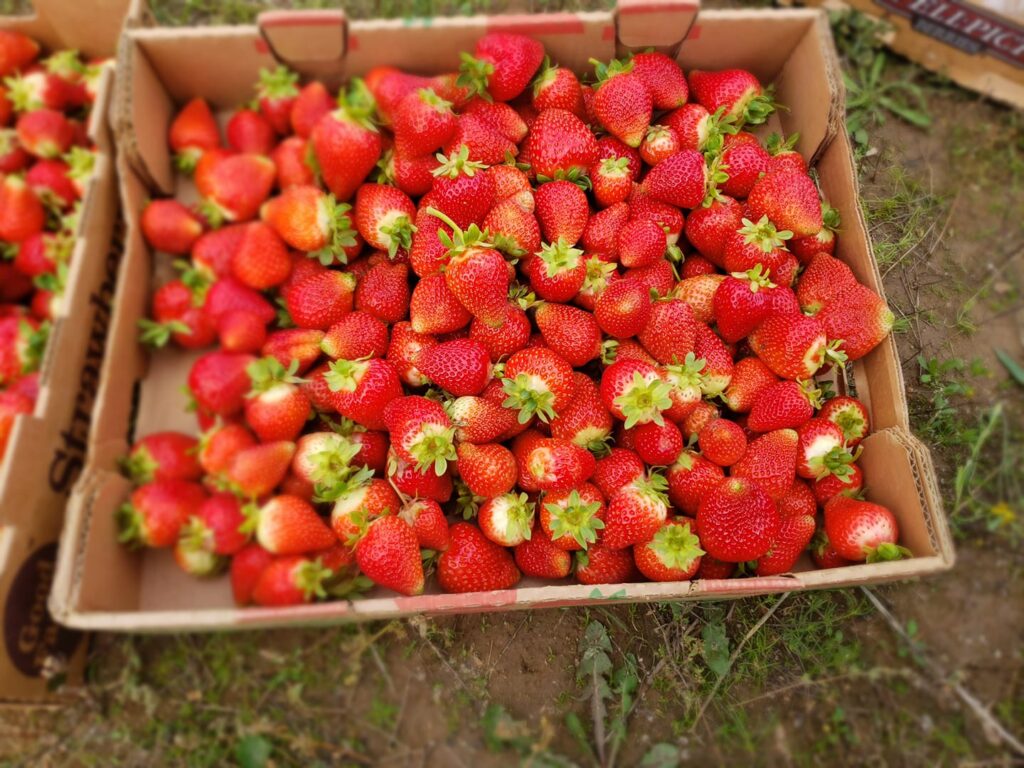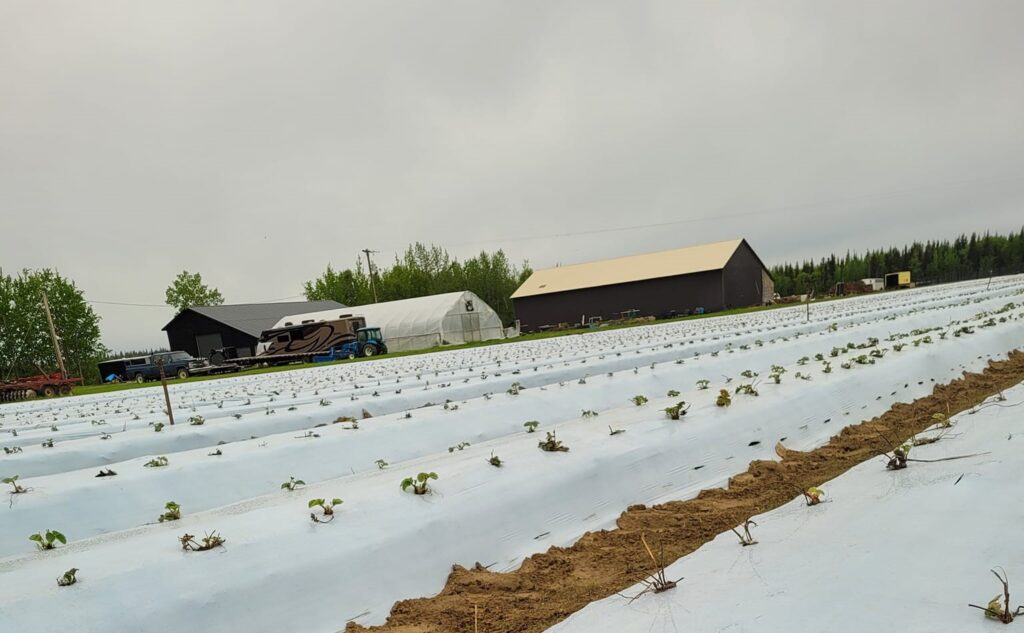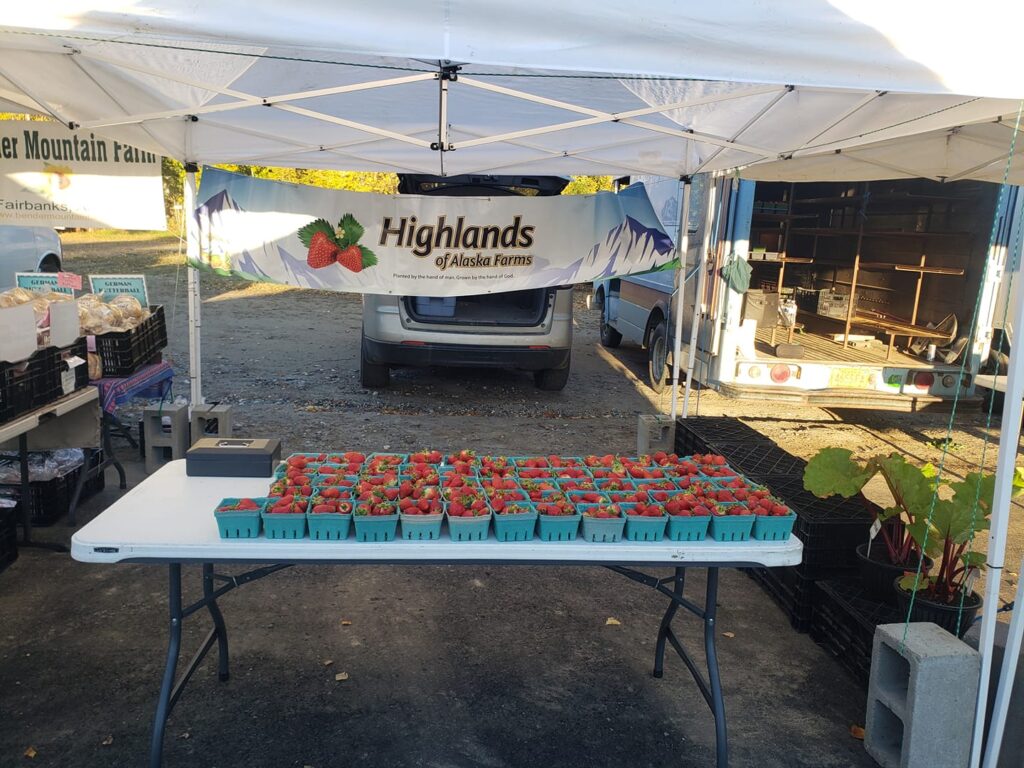There are never enough strawberries in our patch — I think my kids and my neighbor’s kids would agree!
I am not the only one who is figuring out how to grow strawberries successfully in Alaska. One of the top posts on my blog, It Grows in Alaska, is Untangling the Mysteries of Growing Strawberries in Alaska. To figure what I can do to bump up my strawberry production, I interviewed Andy Harper, a local strawberry farmer in Two Rivers, Alaska, as well as University of Minnesota researchers who have studied annual strawberry production using a low tunnel system.

Andy has a half acre of strawberries in production this year. Some of those plants are research plants. He said he started the farm because, “I love berries, I lived in the UK and Scotland, they love black currants, I love those. I met Papa [Meunier] and he had everything. All different types of berries. I just loved berries. So I decided I wanted to do berry farming. Strawberries are the only ones I can make money on the first year.”
(Papa “Larry” Meunier was a legendary berry grower and cultivator in Interior Alaska and a longtime Tanana Valley Farmers Market vendor.)
When Andy buys his own farm, he plans to expand production to many other types of berries. Most berries take a few years to get established.
One of the biggest considerations when planting strawberries is the variety. I wrote about that in detail in my blog. Two particularly important aspects of the variety is their response to day length (or lack thereof) and whether or not they can survive our harsh winters. This is a moving target since our winters are getting less harsh alarmingly quickly.
Also important is taste (of course!), texture, and productivity. Andy primarily grows day-neutral variety Albion. He also grows the June bearer, Cabot, usually as an annual, but it could survive in a non-raised bed growing system. June bearers often are more productive in subsequent years rather than in their first year of growth.
I am growing Fort Laramie strawberries, which are everbearers. That’s what was available at two local nurseries this year. I was told that it was both productive and hardy and would come back next year. But if I were to overwinter it, I should pinch the blossoms and runners. Instead, I’m going for instant gratification and hope to maximize production this year.
Seascape is another popular variety in Alaska.
After these interviews, I realized I had not been paying enough attention to how I planted the bare root strawberries. I learned that you have to take special care that the strawberry roots do not make a “J” when you plant them. They must go straight down into the soil. Andy uses a dandelion weeder to shove the plants into the soil, then clips the ends of the roots with the tool with an extra shove at the end.
Retired University of Minnesota researcher Dr. Steve Poppe wraps the root around a dull 12-inch plant stake so that the root goes straight down into the ground. Loose soil with good tilth is also key for successful planting and good strawberry growth. Compact clay soil will make planting the strawberries the right way difficult. This video shows how to plant strawberries and this photo shows the planting technique with a stake.
Andy spaces his plants 12 inches apart, two rows in a bed. I planted three rows per bed, which worked out well since quite a few of my berries didn’t make it, possibly because of my poor planting technique.
When growing strawberries as annuals, to maximize productivity you’ll want to use at least a plastic mulch to block the weeds. A low tunnel, caterpillar tunnel, high tunnel, or greenhouse also works well.
Overheating can be a concern as strawberries prefer 60-80 degrees Fahrenheit, so having the ability to remove the tunnel or move the high tunnel is important. The University of Minnesota has done extensive research on growing strawberries using a low tunnel system.
Growing in containers or a hanging basket can also be a way to provide the heat needed to get the berries going in the spring or extend the season in the fall if you can bring them into a warm place. Containers or hanging baskets heat up more than growing plants in the soil. Originally, Andy used a reflective mulch similar to tin foil and found it burned the plants. Now he’s using a white mulch, which can aid in cooling the soil.

Andy strategically fertilizes based on a sap analysis he sends to Advancing Eco Agriculture once or twice a season. Although he relied solely on organic fertilizers at the beginning, he’s now incorporating some conventional fertilizers, usually through fertigation (incorporating the fertilizer into the water) once a week. He uses 9-45-15. He said that he should be able to get a half-pound of strawberries per plant but he’s only getting about a fifth of a pound.
Although I have gardened organically for many years, this year, I chose to use conventional and organic fertilizer. I stay away from pesticides and herbicides. Strawberries (and squash and corn, for example) are heavy feeders. Many organic fertilizers are not immediately available to plants especially with the cooler springs we’ve been having. We’re both hoping to bump our production with the addition of some conventional fertilizers.
On the sustainability front, in theory organic fertilizers are better for the environment, but they’re also heavy. When you factor in having to ship heavy organic fertilizers long distances, that adds to your carbon footprint. Your pocketbook also takes a hit. As with everything, there are pros and cons to consider.
Andy removes runners and daughter plants immediately when he sees them. Since these strawberries are grown as annuals, there is no reason to let those grow. If you were hoping to overwinter your plants, you would let them proliferate. Andy does not remove flowers.
I asked Andy if he would do anything differently when he started his farm and he said that he would have used conventional fertilizer sooner. For aspiring strawberry farmers, his biggest advice is to find other strawberry farmers and others in the strawberry industry, particularly at national association conferences, who can mentor you.
He said, “Getting that knowledge sooner gets you further ahead (and) helps you so you don’t make those mistakes.” He also advises persistence and to experiment to find out what you and your customer like. In The Lean Farmer Ben Hartman reiterates this and says that early on in farming you should be doing a lot of experimenting. Then once you find what works after your second or third year of farming, you should try to keep your experiments and creativity to 15 percent, otherwise it gets to be too costly.
Put simply, Andy’s inspiration to farm is that, “I just like people enjoying food. If there are no farmers, nobody eats. I play a part in helping people eat. Farming is relaxing.”

You can find more in depth information on growing strawberries as annuals in Alaska.
For any aspiring strawberry farmers, the University of Minnesota produced a series of videos as well as detailed budget spreadsheets. The budget spreadsheets are not posted online but you can email Emily Tepe with the University of Minnesota Extension if you are interested (etepe@umn.edu).
Published in the Fairbanks Daily Newsminer July 9, 2023.